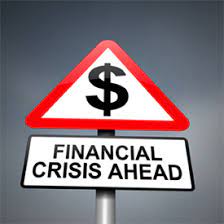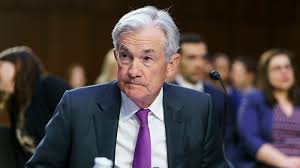The Financial System Shakeup Has Begun
The First Banks To Fail Will Not Be The Last
The Federal Reserve’s 15-year experiment with 0% interest rates and excessive money creation has reached its convulsive concluding phase. What we are seeing now are the so-called unintended consequences about which others have been warning. The turmoil, pain and suffering necessary to right the ship is at hand.



Stormy weather approaches Federal Reserve Building
GETTY
There is no easy cure for what ails the U.S. financial system. The Wall Street Journal today (Wednesday, March 22) is filled with must-read articles describing many of the irreparable imbalances. Their correction phases will involve reversals, shakeups and washouts.
Very importantly, there is no going back. The Federal Reserve’s 15-year experiment with 0% interest rates and excessive money creation has reached its convulsive concluding phase. What we are seeing now are the so-called unintended consequences about which others have been warning. The turmoil, pain and suffering necessary to right the ship is at hand.
Is it a recession?
Yes, but it’s not limited to the typical economic (GDP) growth decline. This period is a financial recession, more commonly described later as a crisis in the final, ugly stages. Why crisis? Because when the financial system gets shaken, it hits everywhere, this time including a deterioration of the currency’s purchasing power (AKA inflation), as we have been experiencing. It always ends with diminished trust in financial institutions, like what has started in the banking system.
Important to note is that this period will produce a strong desire to ferret out the people who caused the problems. The Federal Reserve will certainly get some of the blame. So, too, will all those leaders whose ignorance and hubris caused them to make egregious mistakes. Then there are those who knowingly milked the system – they are generally exposed by the media’s investigative journalists.
Does all this sound over the top – simply scare tactics?
Of course. That’s because we are still in the initial stage where there is the hopeful belief that something can be done to correct the problems. For example, the Fed’s secret “emergency” meeting that produced the supposed cure to the depositor run problem at two regional banks: Insuring all their deposits, including those over the FDIC maximum of $250M.
However, to achieve that solution, the Fed had to label the two regional banks’ problems as “systemic,” meaning that, if left unresolved, they could cause widespread banking system turmoil.
So, is that it? No. As last week’s markets see-sawed, it became clear that – as usual – the first banks to fail are not the last. They are simply the ones that adopted tactics furthermost from sound banking actions. They are the smoke that foreshadows the firestorm. And there is plenty of additional fuel – over 300 other U.S. regional banks. And, yes, many are at risk because banks regularly play follow-the-leader when competing for growth.
As proof, Wall Street analysts now are busy reanalyzing the regional banks – and knocking down the weak, riskier ones. Over 100 are now down 20% or more year-to-date and down over 1/3 from their 52-week highs. Those decliners are the antithesis of the steady-and-safe stocks investors thought they owned.
Watch out for value traps
The financial reversals are happening quickly, meaning the typical value measures are suddenly flashing green – buy! However, the coming revenue and earnings reports will reveal the problematic reality.
And then there are those attractive dividend yields. When revenues and earnings decline, boards will ensure that dividend payments are cut or halted.
About the bank managements following one another… Really?
Yes. At one point during my investment career, I worked with a marketing manager who handled investment products for banks. He told me the beauty of his job was that bank managers were like sheep. Successfully get a couple of banks to act, he said, and soon the others want on board.
A current example is in The Wall Street Journal: “Property Debt Adds to Lender Worries” (page B1).
“A record amount of commercial mortgages expiring in 2023 is set to test the financial health of small and regional banks already under pressure following the recent failures of Silicon Valley Bank and Signature Bank.
“Smaller banks hold around $2.3 trillion in commercial real estate debt, including rental-apartment mortgages, according to an analysis from data firm Trepp Inc. That is almost 80% of commercial mortgages held by all banks.”
“This year will be critical because about $270 billion in commercial mortgages held by banks are set to expire, according to Trepp—the highest figure on record. Most of these loans are held by banks with less than $250 billion in assets.
“If those loans pay off, it would reassure markets. But a large number of defaults could force banks to mark down the value of these and other loans, analysts say, reinforcing fears over the financial health of the U.S. banking system.”
The rest of the article discusses the problems commercial property owners have – primarily the downsized demand for space and the higher loan interest rates. Add in a conservative lending shift by banks and payoffs could be a concern.
The bottom line: It’s not just the regional banks
While the focus is on the regional banks because of the dual bank problems, there is trouble afoot throughout the financial system. Moreover, there are linkages between different types of financial firms and different types of financial instruments. A shift in one place can produce a surprising shift elsewhere, either naturally or with the help of someone’s investment strategy (think hedge funds).
So, expect that the regional bank problems will not be cured and that the root causes have already infected other financial firms, albeit in different ways. In other words, focus on avoiding the many ways a troubled financial system could adversely affect both your investments and your personal finances.
During my 30-year career, I managed and consulted to multi-billion dollar funds. Using the “multi-manager” approach, I worked with leading



